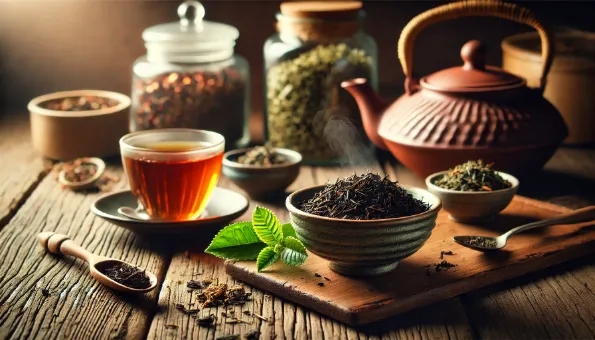Tea Leaves: Antioxidants, Caffeine & L-Theanine
Leaves of Camellia sinensis—green, black, oolong, white and pu-erh—offering antioxidants, gentle caffeine, and calming L-theanine.

What Are Tea Leaves?
All true tea comes from ***Camellia sinensis***. Processing determines the style: **green** (minimally oxidized), **black** (fully oxidized), **oolong** (partially oxidized), **white** (young buds/leaves, lightly processed), and **pu-erh** (fermented/aged).
Nutrition (per 1 cup brewed, unsweetened ~240 ml)
- **Calories:** ~0–2
- **Caffeine:** ~20–70 mg (type/steep time)
- **L-theanine:** ~6–20 mg (generally higher in shaded teas)
- **Polyphenols:** catechins (EGCG) in green; theaflavins/thearubigins in black
Benefits
- **Antioxidants** support cellular protection
- **Caffeine + L-theanine**: alert yet calm focus
- Naturally **very low-calorie** beverage
- May support **oral health** (tea polyphenols) and hydration
Considerations
- **Tannins** can inhibit iron absorption—avoid drinking tea with iron-rich meals
- **Caffeine sensitivity**: choose decaf or shorter steeps
- Strong/bitter brews may upset sensitive stomachs
- In pregnancy, limit total **caffeine** intake per medical guidance
How to Use
- **Brewing basics (per 250 ml):** 2–3 g leaves; green/white **70–80°C for 1–3 min**; oolong **85–95°C for 2–4 min**; black/pu-erh **95–100°C for 3–5 min**
- **Cold brew:** 8–12 g per liter, 6–12 h in fridge—smooth, low bitterness
- **Culinary:** **matcha** in lattes & baking; **tea-smoked** proteins; infuse **syrups, custards, broths**
Summary
Tea leaves deliver antioxidants and a balanced lift from caffeine with calming L-theanine—brew gently to match the style.
- 1. Tea Leaves
tea leaves – listići *Camellia sinensis* (zeleni, crni, oolong, bijeli, pu-erh); prirodni izvor kofeina, L-teanina i polifenola (katehini, teaflavini)

